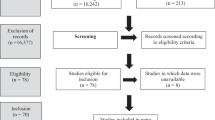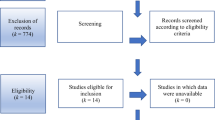Abstract
Though mentoring has emerged as a promising and low-cost intervention for at-risk youth in recent years, the scientific knowledge base on the topic remains under-developed. The current study augments the knowledge base on youth mentoring by analyzing programmatic elements of mentoring programs situated in or adjacent to the juvenile justice system that are predictive of participant success. Poisson regression was utilized to analyze data collected through a national mentoring community saturation survey. Findings indicated that mentoring programs that require more frequent interaction and sustain relationships for longer timeframes realize higher success rates. Similarly, the use of formal mentor training was also observed as indicative of the use of evidence based practices and higher success rates, though likely beyond the logistical and fiscal reach of some local mentoring initiatives. The implications for further research and the mentoring community are discussed.





Similar content being viewed by others
Notes
It is worth noting that a similar pattern of findings emerged when the sample was restricted to mentoring programs that serve juvenile-justice-involved youth. Specifically, mentoring respondents were asked whether at least 10 % of the youth served by their program are referred from the juvenile justice system. When the sample was restricted to respondents who said “yes” to this question, the pattern of findings for models 1, 2, and 3 were substantively identical. Findings from model 4 changed slightly: the effect of meeting frequency was .13 (p < .05), the effect of meeting length was .07 (p > .05), and the effect of mentor training was .16 (p < .05).
References
Baker, D. B., & McGuire, C. P. (2005). Mentoring in historical perspective. In D. L. DuBois & M. J. Karcher (Eds.), Handbook of youth mentoring (pp. 14–29).
Barnes, J. C., Miller, J. M., Miller, H. V., & Gibson, C. L. (2008). Juvenile drug court program admission, demeanor and cherry-picking: a research note. American Journal of Criminal Justice, 33(2).
Barnes, J. C., Miller, H. V., & Miller, J. M. (2009). Identifying leading characteristics associated with juvenile drug court admission and success: A research note. Youth Violence and Juvenile Justice, 7(4), 350–360.
Bazron, B. J., Brock, L., Read, N., & Segal, A. (2006). The mentoring tool-kit: Resources for developing programs for incarcerated youth (Unabridged version). Washington, D.C.: National Evaluation and Technical Assistance Center for the Education of Children and Youth who are Neglected, Delinquent and At-Risk, U.S. Department of Education.
Blechman, E. A., & Bopp, J. M. (2005). Juvenile offenders. In D. L. DuBois & M. J. Karcher (Eds.), Handbook of youth mentoring (pp. 454–466).
Bogat, G. A., & Liang, B. (2005). Gender in mentoring relationships. In D. L. DuBois & M. J. Karcher (Eds.), Handbook of youth mentoring (pp. 205–217).
Bouffard, J. A., & Bergseth, K. J. (2008). The impact of reentry services on juvenile offenders’ recidivism. Youth Violence and Juvenile Justice, 6(3), 295–318.
Cavell, T. A. & Smith, A. (2005). Mentoring children. In D. L. DuBois & M. J. Karcher (Eds.), Handbook of youth mentoring (pp. 160–176).
Cavell T., DuBois D., Karcher M., Keller T., & Rhodes J. (2009). Strengthening mentoring opportunities for at-risk youth [policy brief]. http://educationnorthwest.org/webfm_send/237. February.
Coyne, S. M., Duffy, J. L., & Wandersman, A. (2005). Mentoring for results: Accountability at the individual, program, community, and policy levels. In D. L. DuBois & M. J. Karcher (Eds.), Handbook of youth mentoring (pp. 546–560).
Dallos, R., & Comley-Ross, P. (2005). Young people’s experience of mentoring: building trust and attachments. Clinical Child Psychology and Psychiatry, 10(3), 369–383.
Dappen, L., & Isernhagen, J. C. (2006). Urban and nonurban schools: examination of a statewide student mentoring program. Urban Education, 41(2), 151–168.
Day, A. (2006). The power of social support: mentoring and resilience. Reclaiming Children and Youth, 14(4), 196–198.
Dondero, G. M. (1997). Mentors: beacons of hope. Adolescence, 32(128), 881–886.
Dubberley, S. (2006). Mentoring for young people leaving care. Probation Journal, 53(2), 172–173.
DuBois, D. L., Holloway, B. E., Valentine, J. C., & Cooper, H. (2002). Effectiveness of mentoring programs: a meta-analytical review. American Journal of Community Psychology, 30, 157–197. doi:10.1023/A:1014628810714.
DuBois, D. L., & Karcher, M. J. (2005). Youth mentoring: Theory, research and practice. In D. L. DuBois & M. J. Karcher (Eds.), Handbook of youth mentoring (pp. 2–11).
DuBois, D. L., Portillo, N., Rhodes, J. E., Silverthorn, N., & Valentine, J. C. (2011). How effective are mentoring programs for youth? A systematic assessment of the evidence. Psychological Science in the Public Interest, 12(2), 57–91.
DuBois, D. L., & Silverthorn, N. (2005). Research methodology. In D. L. DuBois & M. J. Karcher (Eds.), Handbook of youth mentoring (pp. 44–64).
Enriquez, A. E. Jr. (2011). Juvenile system mentoring programs in Bexar county: Referrals and recidivism. (Unpublished master’s thesis). University of Texas at San Antonio.
Grossman, J. B., Chan, C. S., Schwartz, S. E., & Rhodes, J. E. (2011). The test of time in school-based mentoring: the role of relationship duration and re-matching on academic outcomes. American Journal of Community Psychology. doi:10.1007/s10464-011-9435-0.
Groves, R. M., Fowler, F. J., Couper, M. P., Lepkowski, J. M., Singer, E., & Tourangeau, R. (2009). Survey methodology (2nd ed.). Hoboken: Wiley.
Jones-Brown, D. D., & Henriquez, Z. W. (1997). Promises and pitfalls of mentoring as a juvenile justice strategy. Social Justice, 24(4), 212–233.
Keating, L. M., Tomishima, M. A., Foster, S., & Alessandri, M. (2002). The effects of a mentoring program on at-risk youth. Adolescence, 37(148), 717–734.
Keller, T. E. (2005). The stages and development of mentoring relationships. In D. L. DuBois & M. J. Karcher (Eds.), Handbook of youth mentoring (pp. 82–99).
Laakso, J., & Nygaard, J. (2007). Children of incarcerated parents project: How a mentoring program can make a difference. Unpublished final report prepared for Washington State Department of Corrections and Big Brothers Big Sisters of King/Pierce County.
Langhout, R. D., Rhodes, J. E., & Osborne, L. E. (2004). An exploratory study of youth mentoring in an urban context: adolescents’ perceptions of relationship styles. Journal of Youth and Adolescence, 33(4), 293–306.
LoSciuto, L., Rajala, A. K., Townsend, T. N., & Taylor, A. S. (1996). An outcome evaluation of across ages: an intergenerational approach to drug prevention. Journal of Adolescent Research, 11(1), 116–129.
McCluskey, K. M., Noller, R. B., Lamoureux, K., & McCluskey, A. L. A. (2004). Unlocking hidden potential through mentoring. Reclaiming Children and Youth, 13(2), 85–93.
MENTOR/National Mentoring Partnership. (2006). Mentoring in America 2005: A snapshot of the current state of mentoring. Retrieved February 20, 2012, from http://www.mentoring.org/downloads/mentoring_523.pdf
Nakkula, M. J., & Harris, J. T. (2005). Assessment of mentoring relationships. In D. L. DuBois & M. J. Karcher (Eds.), Handbook of youth mentoring (pp. 100–117).
Newburn, T., & Shiner, M. (2006). Young people, mentoring and social inclusion. Youth Justice, 6(1), 23–41.
Office of Justice Programs. (2011). Fact sheet: Mentoring. Washington, D.C.: U.S. Department of Justice. Retrieved February 20, 2012, from http://www.ojp.usdoj.gov/newsroom/factsheets/ojpfs_mentoring.html
Portwood, S. G., & Ayers, P. M. (2005). Schools. In D. L. DuBois & M. J. Karcher (Eds.), Handbook of youth mentoring (pp. 336–347).
Pryce, J. M., & Keller, T. E. (2011). Interpersonal tone within school-based youth mentoring relationships. Youth & Society. doi:10.1177/0044118X11409068. Advance online publication.
Rhodes, J. E. (2005). A model of youth mentoring. In D. L. DuBois & M. J. Karcher (Eds.), Handbook of youth mentoring (pp. 30–43).
Rhodes, J. E., & DuBois, D. L. (2008). Mentoring relationships and programs for youth. Current Directions in Psychological Science, 17(4), 254–258.
Sipe, C. L. (2005). Toward a typology of mentoring. In D. L. DuBois & M. J. Karcher (Eds.), Handbook of youth mentoring (pp. 65–80).
Smith, C. A., & Stormont, M. A. (2011). Building an effective school-based mentoring program. Intervention in School and Clinic, 47(1), 14–21.
Spencer, R. (2006). Understanding the mentoring process between adolescents and adults. Youth & Society, 37(3), 287–315.
Spencer, R. (2007). “It’s not what I expected”: a qualitative study of youth mentoring relationship failures. Journal of Adolescent Research, 22(4), 331–354.
Thomas R. E., Lorenzetti, D., & Spragins, W. (2011). Mentoring adolescents to prevent drug and alcohol use. Cochrane Database of Systematic Reviews 2011, 11, CD007381. doi:10.1002/14651858.CD007381.pub2
Thompson, N. R., & Zand, D. H. (2010). Mentees’ Perceptions of their interpersonal relationships: the role of the mentor-youth bond. Youth & Society, 41(3), 434–445.
Tolan, P., Henry, D., Schoeny, M., & Bass, A., (2008). Mentoring interventions to affect juvenile delinquency and associated problems.Campbell Systematic Reviews, 16. doi:10.4073/csr.2008.16.
Wood, S., & Mayo-Wilson, E. (2012). School-based mentoring for adolescents: a systematic review and meta-analysis. Research on Social Work Practice. doi:10.1177/1049731511430836. Advance online publication.
Author information
Authors and Affiliations
Corresponding author
Additional information
This project was supported by Grant #2010-JU-FX-0118 awarded by the Office of Juvenile Justice and Delinquency Prevention, Office of Justice Programs, U.S. Department of Justice. The opinions, findings, and conclusions or recommendations expressed in this publication are those of the author(s) and do not necessarily reflect those of the Department of Justice. The authors wish to thank the grant partners (MENTOR, The National Mentoring Partnership; Global Youth Justice; and the National Partnership for Juvenile Services) for input and assistance on the development of data collection instruments. We would also like to thank Barbara Tatem Kelley of the Office of Juvenile Justice and Delinquency Prevention for project guidance and direction.
Rights and permissions
About this article
Cite this article
Miller, J.M., Barnes, J.C., Miller, H.V. et al. Exploring the Link between Mentoring Program Structure & Success Rates: Results from a National Survey. Am J Crim Just 38, 439–456 (2013). https://doi.org/10.1007/s12103-012-9188-9
Received:
Accepted:
Published:
Issue Date:
DOI: https://doi.org/10.1007/s12103-012-9188-9




